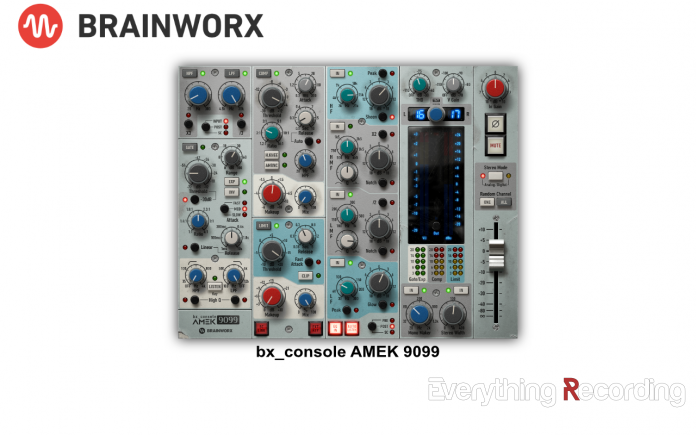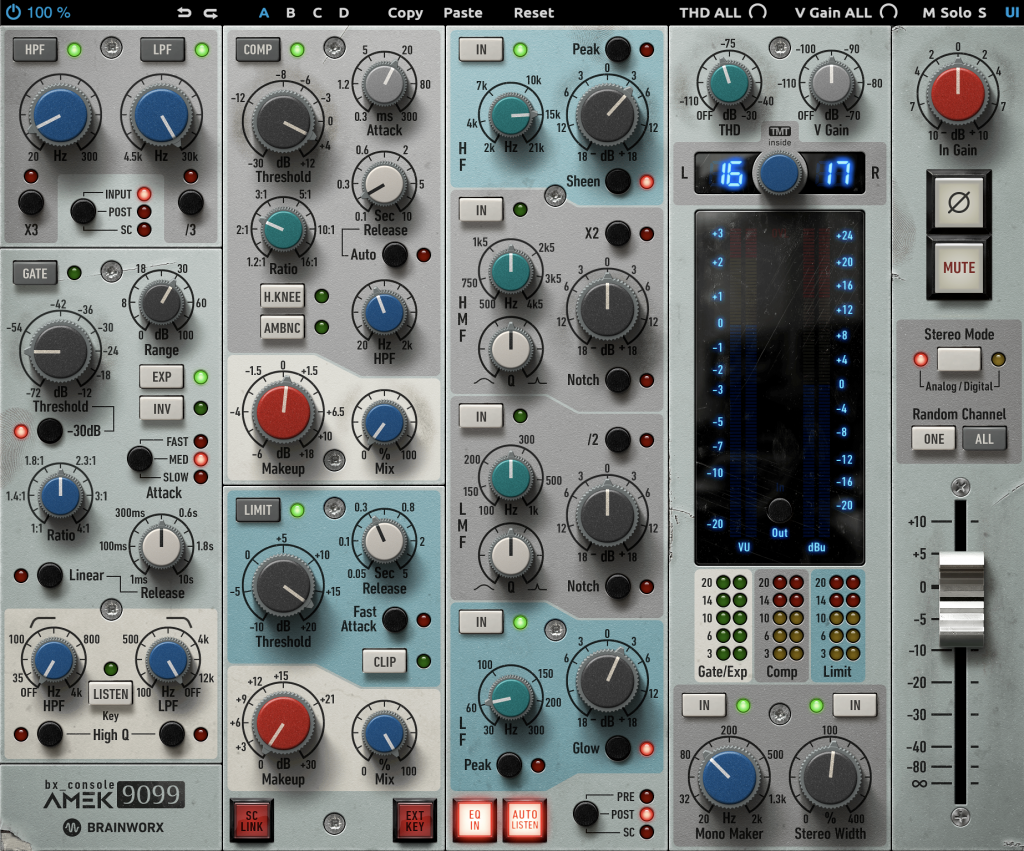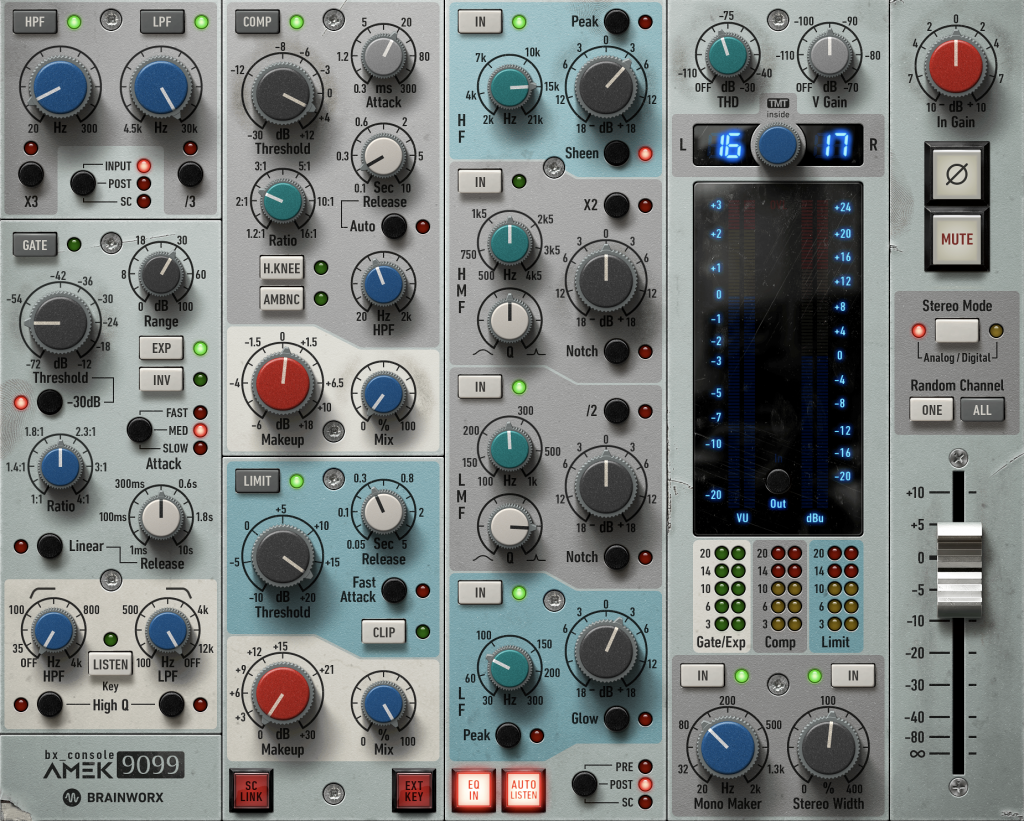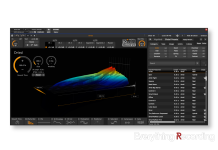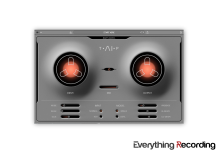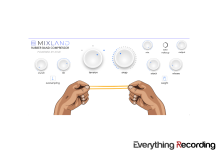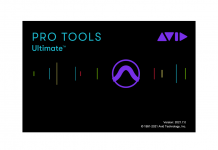Today, we take on a console that comes full circle from analog to digital, back to analog, and then to plugin form. Of course, we’re talking about Brainworx’s most ambitious bx_console plugin yet – Amek 9099.
Back to the Future
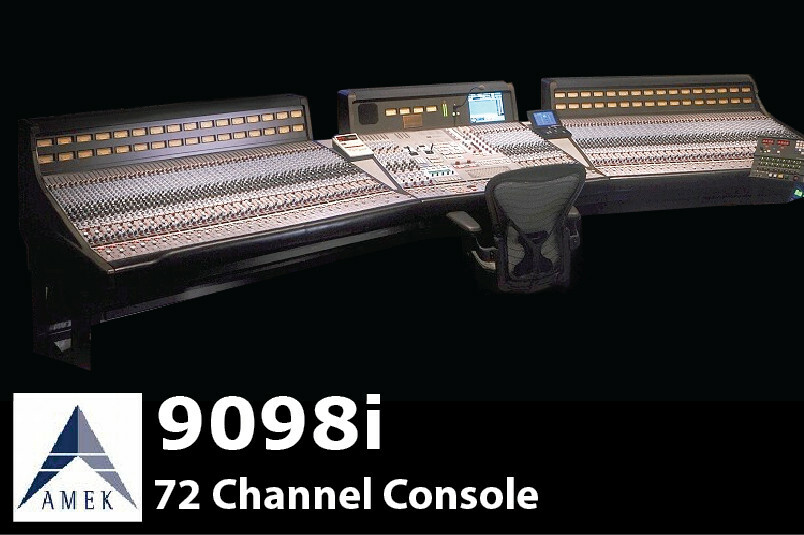

The year is 2000. Modern computing has hit the mainstream, and everyone can’t get enough. This appeal also gets companies at the forefront of technology thinking, “How can we apply this to our field?”
In pro audio, Amek was that company introducing one of the most groundbreaking mixing consoles ever made. The Amek 9098i still stands as one of the precursors to today’s hybrid workstations. They essentially threw everything in but the kitchen sink at the design, even bringing analog royalty Rupert Neve. Amek was very proud to have Mr. Neve, as shown in the pages of the 9098’s print brochure.

The $500,000 Question
So what does the 500,000$ (2021 Equivalent to $789,0000) get you in the year 2000? For the time, a surprisingly advanced console. First, you have a 400MHz Intel Celeron processor running MS-DOS. You may wonder what you would need a small computer for in an analog console. Well, the 9098i is not fully analog. Amek incorporated “Virtual Dynamics” by way of their CAP (Central Assignment Panel). This piece of software housed what could be considered the precursor to plugins. You’re given 12 different processors to choose from that you can assign to any of the console’s VCA faders. Crazy enough, the Virtual Dynamics suite even had an Auto Panner that you could sync via MIDI. This is extremely impressive for the year 2000. The future sure was looking bright!
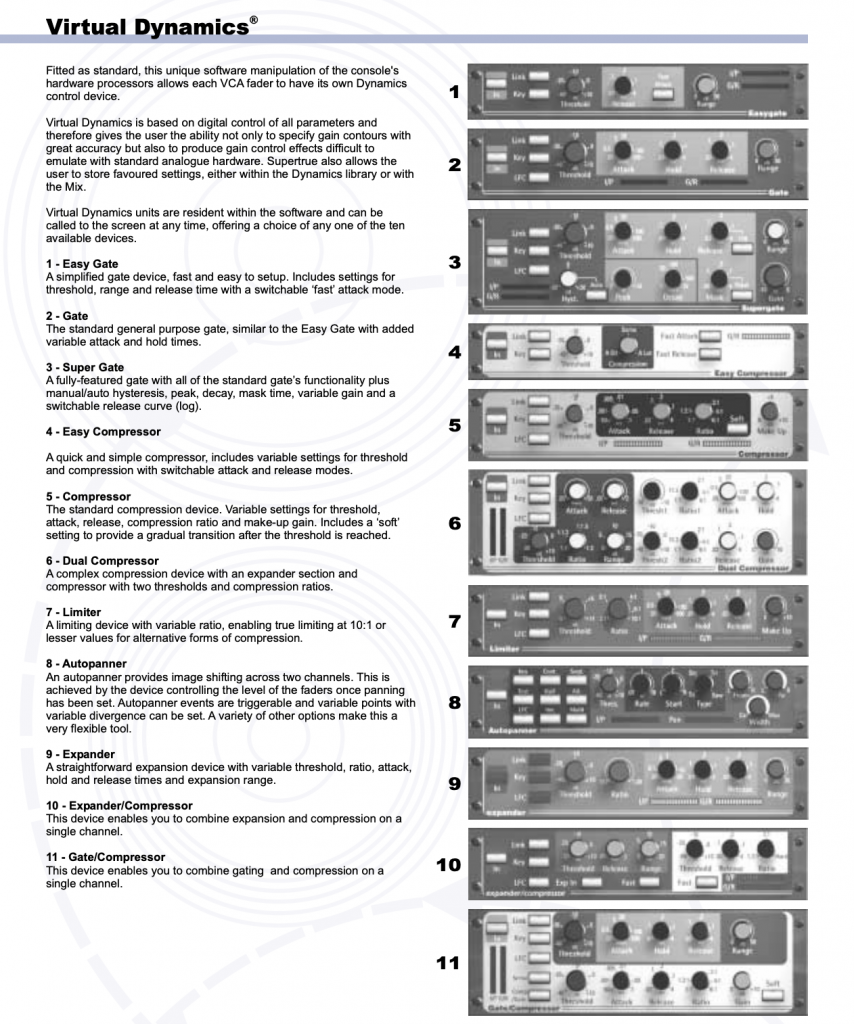
The 9098i also included an integrated trackball and keyboard to control Virtual Dynamics and automation parameters. Unfortunately, in only what could be due to the high cost of monitors, the 9089i had a paltry 12.1″ monitor in the meter bridge. I think Amek knew at the time that trying to tweak an attack time on what is the modern-day equivalent to an iPad from 4 feet away wasn’t going to cut it. So they added another VGA port for your own monitor. Break out the Sony Trinitron!
The Sign of Things to Come
Being at the forefront of plugins and DAWs wasn’t always easy, but some saw the writing on the wall – Like Mix Magazine’s Larry the O. Let’s take a look at his Amek 9098i review from Mix Magazine.
“To me, knobs and buttons are, on the whole, much better physical than virtual controllers, and graphic or text representations of parameter values can be more clear than a picture of a knob. Trying to drag a virtual pot by rolling a trackball while simultaneously holding down a button with the same hand is awkward and, over the long haul, unhealthy. However, there seems no stopping this trend.”
Overall, the console still retained its Analog soul by incorporating Rupert Neve’s TLA (Transformer Like Amplifier) design for the input modules. Additionally, the 4 band EQ had features not usually seen on consoles like a “notch” button on the mid bands for precise cutting, Glow, and Sheen buttons to change the filter curve of the low and high shelves, and the ability to use the EQ bands to feed the sidechain of the dynamics. Lastly, the stereo sections had a “Width” control that utilized the introduction of cross panned, and phase flipped material on each side of the field.
Which Brings Us to Today
You rarely see a console with this many features, so you can see why Brainworx wanted to include this in their bx_console line. Additionally, this series also holds a special place in Brainworx creator and owner Dirk Ulrich’s heart. It happened to be one of the first “really high-end channel strips” he bought when he finally had the budget.
Not to rest on their laurels, Brainworx took this particular bx_console plugin to new heights, adding even more features than the original console along with a few tricks that no other bx_console plugin has.
Same but Different
The bx_console AMEK 9099 still retains the same proprietary Brainworx TMT (Tolerance Modeling Technology) as all of the other consoles in the lineup. In addition, you’re given different variants of individual channels of the original console that you can select in series or randomly via the “Random” buttons.
What sets AMEK 9099 from the other consoles are several genius features. While the original AMEK 9098i console had a Width control, Utilizing their extensive knowledge of Mid/Side processing, Brainworx took the concept further by including a Stereo Width and Mono Maker control. The Stereo Width improves on the console’s version by retaining your center section while widening. Additionally, the Mono Maker borrows from other Brainworx plugins to fold the processed sound at and below the selected frequency of the knob into the center of the field. This is very useful in cleaning up the sides of a mix and focusing the low-end content into the middle for tighter bass.
What could be the more useful feature ever placed in an “analog non-graphed EQ) has to be AMEK 9099’s “Auto Listen” button in the EQ section. When selected, every time you select a frequency or Q control on a band of EQ, it solos the band. This is IMMENSELY useful when sweeping for that problem frequency. More developers need to add this to EQ plugins, and I’m BEGGING Brainworx to add it to all of the other bx_console models (or at least the Focusrite SC. We will consider it a personal favor). Rounding out the “not on any other bx_console” features is a “Soft Clip” option for the limiter, fully functional Expander / Gate with its own sidechain filters, along with the ability to use your EQ filters to sidechain your Compressor / Limiter.
Interface
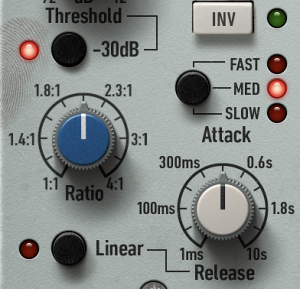
Although the interface naturally has quite a bit of knobs, it’s not at all intimidating. All of the knobs are color-coded to match their function, so it’s easy to glance and get around. The many dynamic parameters could easily get cluttered with too much feedback, but the interface brilliantly transforms knobs and visual feedback to accommodate the new task. For example, take the Gate sidechain filters: with the “High Q” setting enabled. The EQ curves above the filter knobs change to show the resonant bump in the filter.
The GUI is easily the best looking yet for Brainworx and deserves a deeper look. You can tell a lot of TLC was put into the design. Just look at the shadowing and reflection on the VU meters and knobs. Yes, we know looks don’t mix a record, but you have to appreciate the aesthetics and visual design when a manufacturer puts this much work into it. Brainworx even went as far as adding a “UI” selector in the top right corner of the plugin. You have the choice between a “spanking new” console or a used one, complete with scratches, discoloration, and even the slovenly engineer’s grease-stained thumbprint (every studio has one, right? If you say no, odds are, it’s probably you. Go wash your hands)
Filtering
 Starting at the top left, we have the filter section with all of the trappings of standard filtering. In normal mode, the High-Pass works from 20Hz – 300Hz, with the option to increase the range from 60Hz – 900Hz via the “x3” button. Similarly, the Low-Pass filter has an “/3” button that will change the standard 4.5k – 30k to 1.5k to 10k. The plugin also added the “x3” and “/3” buttons for more versatility. For even more control over filters, bx_console AMEK 9099 allows both filters to be placed at the input, post dynamics, or into the sidechain of the dynamics sidechain. Think of it as a “master sidechain” control for all dynamics in addition to the Gate and Compressor sidechain filters.
Starting at the top left, we have the filter section with all of the trappings of standard filtering. In normal mode, the High-Pass works from 20Hz – 300Hz, with the option to increase the range from 60Hz – 900Hz via the “x3” button. Similarly, the Low-Pass filter has an “/3” button that will change the standard 4.5k – 30k to 1.5k to 10k. The plugin also added the “x3” and “/3” buttons for more versatility. For even more control over filters, bx_console AMEK 9099 allows both filters to be placed at the input, post dynamics, or into the sidechain of the dynamics sidechain. Think of it as a “master sidechain” control for all dynamics in addition to the Gate and Compressor sidechain filters.
Dynamics, Dynamics, Dynamics
Gate / Expander / Everything in Between
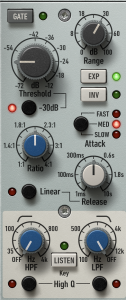 Because the original 9098i had so many modules via the “Virtual Dynamics,” Brainworx pushed their version to the limit with just about every option you could need – all in one window. Starting from the left, we have the Gate / Expander section. In our bx_console N review, we loved the gate section. This one is no different, expanding (sorry, I couldn’t help myself) on the original with more bells and whistles.
Because the original 9098i had so many modules via the “Virtual Dynamics,” Brainworx pushed their version to the limit with just about every option you could need – all in one window. Starting from the left, we have the Gate / Expander section. In our bx_console N review, we loved the gate section. This one is no different, expanding (sorry, I couldn’t help myself) on the original with more bells and whistles.
The Gate section clocks in with your normal controls of threshold, attack, release, and ratio, but it’s the other buttons and knobs that stand out. First, we have the “Listen” button. This lets you spy on what’s triggering the gate. This is especially useful with drums when trying to find that perfect spot for gating. Additionally, the Gate section has a sidechain section complete with a High Q button for each filter. This adds a resonant bump at the frequency you sidechain to make the gate especially sensitive to that frequency.
Everything Recording AMEK 9099 hack: If I’m not doing any additional processing or want to do creative filtering, I use the Gate’s HPF and LPF with the High Q. It has more range than the console’s high pass and low pass and the resonant bump at the frequency adds a special “oomph”. Maybe Brainworx could give us the option to use the Gate’s filters instead of the ones at the top. It should be an easy addition. Just put a button on the top filter to route to the Gate’s filters and continue through the plugin chain.
Expanded Controls
In addition to the helpful sidechain Listen, the Gate can also switch to an Expander. With the EXP button clicked, the Hold button under the Threshold transforms to a Ratio. Three modes control the attack with the Attack button but Release is variable. You’re even given a Linear option for release. By default, the release works on an exponential level. Linear mode lets go on a straight line.
Lastly, the Gate / Expander section has an INV button. INV is short for “inverse,” and it does just that. Instead of gating or expanding the source material, it shows you what it’s removing. Essentially, the INV button is like having a teenage kid – it does the opposite of what you tell it to. If you’re familiar with gating and expanding, it’s a great creative tool. If you’re new to audio, INV can show you what the processor is doing, therefore a great learning tool.
Compression with a Side of De-Compression
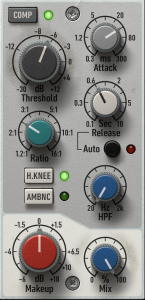 Continuing the engineering equivalent of “Doomsday Prepping,” the Compressor / Limiter section leaves no stone unturned. We all know how a compressor works for the most part, so we understand we have the standard controls all dynamics tools have with threshold, attack, release, a ratio that goes up to 16:1, and makeup gain. However, it’s the additional controls that make this compressor section a veritable swiss army knife.
Continuing the engineering equivalent of “Doomsday Prepping,” the Compressor / Limiter section leaves no stone unturned. We all know how a compressor works for the most part, so we understand we have the standard controls all dynamics tools have with threshold, attack, release, a ratio that goes up to 16:1, and makeup gain. However, it’s the additional controls that make this compressor section a veritable swiss army knife.
Off of the original 9098i Virtual Dynamics, you’re given an auto-release feature, hard knee, additional High-Pass sidechain filter for the detector. Probably the most interesting feature of the 9098i’s original Virtual Dynamics is the Ambience mode. Similar to the Gate’s INV control, Ambience actually shows you what the compressor is doing, essentially almost “uncompressing” the track. It’s a great tool for those wanting to learn the basics of compression, not to mention an interesting sounding processor. Depending on how you adjust the attack and release, it works as a quasi-gate / transient designer. Slowing the attack ever so slightly can soften the snap of a transient. Combine that with the Brainworx-added compressor Mix knob, and you’re off to the races.
Take it to the Limit
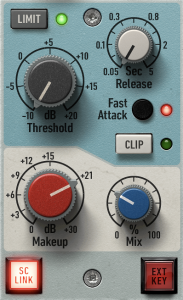 Just below the Compressor, we have the Limiter. This section has the same controls as the original (threshold, fast attack, and release), but Brainworx saw more unique extras they wanted to add. First, they added the same mix control and makeup gain as the compressor section. Additionally, Brainworx added a “Clip” button that uses swift attack and release times to shave off the transient above the threshold. Once enabled, the Release knob cleverly disappears not to distract you, and you now have a new dynamics tool. Combine the Fast Attack button, and you can really do some damage. Light use can reduce peaks without sacrificing the tail of the transient, and heavy use can push into creative distortion. This effect is similar to the Peak Stop Limiter section on Arturia’s COMP VCA-65 and can be used for very creative purposes when combined with the Mix control.
Just below the Compressor, we have the Limiter. This section has the same controls as the original (threshold, fast attack, and release), but Brainworx saw more unique extras they wanted to add. First, they added the same mix control and makeup gain as the compressor section. Additionally, Brainworx added a “Clip” button that uses swift attack and release times to shave off the transient above the threshold. Once enabled, the Release knob cleverly disappears not to distract you, and you now have a new dynamics tool. Combine the Fast Attack button, and you can really do some damage. Light use can reduce peaks without sacrificing the tail of the transient, and heavy use can push into creative distortion. This effect is similar to the Peak Stop Limiter section on Arturia’s COMP VCA-65 and can be used for very creative purposes when combined with the Mix control.
Rounding out the entire dynamics section are the SC Link and Ext Key buttons at the bottom of the Limiter’s section. The Ext Key button enables external sidechaining from your DAW, perfect for keying a bass track off the kick drum. The SC Link enables the linking of two stereo channels. That way, the same gain reduction occurs between both channels for each instance’s compressor, gate, and limiter. When used with the gate, one channel’s signal can trigger the gate on both, and with the compressor or limiter, gain reduction is maximized on both channels. Interesting stuff.
Big Bands
 This EQ section is easily one of the most feature-loaded EQs I’ve seen on an analog console. Hell, it’s one of the most loaded in software versions. Brainworx carefully recreated this EQ, only adding a couple of extra features to set this EQ into legendary territory. This isn’t due to Brainworx slacking – the original just had that many features.
This EQ section is easily one of the most feature-loaded EQs I’ve seen on an analog console. Hell, it’s one of the most loaded in software versions. Brainworx carefully recreated this EQ, only adding a couple of extra features to set this EQ into legendary territory. This isn’t due to Brainworx slacking – the original just had that many features.
You’re given four parametric bands that can be placed either pre-dynamics, post-dynamics or fed into the sidechain of the dynamics. You also have that awesome Brainworx-added “Auto Listen” button we mentioned earlier that solos each band as you adjust the “Q” or Frequency. The Low and High filters can be either Shelf or Peak (via the Peak button) and even have the original 8098i’s “Sheen” and “Glow” options. These buttons work respectively with the High and Low bands and change the curve to a broader, more subtle one. The Glow creates a more “rounded” low end, while the Sheen gives you a nice sparkly halo around the top.
Don’t think the mid bands didn’t get any love because you’re given a “Notch” button that transforms the band into a surgical EQ, complete with “Q” control for the width. This is perfect for catching those annoying resonances in a snare or acoustic guitar. Brainworx also added an “x3” control that changes the High-Mid band and an “/3” that adjusts the range on the Low-Mid band. What more could you want in an EQ?
Output Section
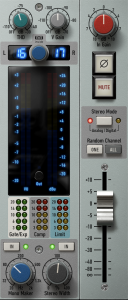 Just because other output sections of channel strip plugins are boring doesn’t mean this one is. We’ve got more knobs and buttons that do cool stuff!
Just because other output sections of channel strip plugins are boring doesn’t mean this one is. We’ve got more knobs and buttons that do cool stuff!
Of course, we have the TMT section like all other bx_console plugins, complete with a rotary knob to change the modeled channels. Just above that are the THD and V Gain knobs that add more virtual voltage into your 1’s and 0’s. Next, you can give your stereo tracks a more authentic console vibe by selecting “Analog” for the Stereo Mode. This uses a different modeled channel for each side of the stereo field. Conversely, Digital will use the same channel for both sides. Lastly, you can randomly peruse the modeled channels with the Random One button for each instance you’re working with or use Random All to change every instance of bx_console AMEK 9099 in your session. This is great after finishing a mix to give a subtle change of timbre in the mix. It’s like being able to randomly route physical channels to different ones on a mixing board with one click of a button.
At the very bottom are the Mono Maker and Stereo Width controls. These two give you the ability to fold the processing of the selected frequency into the middle of the stereo field and push the stereo signal more to the sides, all while still maintaining imaging. The remaining controls give you input gain, phase, mute, and a fader for the output signal.
In Use
I own several bx_console plugins. I honestly think if you’re going to own one of these plugins in the series, it HAS to be this one. This is a textbook example of balancing utility and workflow with the best analog has to offer. The closest adjective I can come up with for the overall sound of AMEK 0900 is “sweet.” The EQ brings out everything you want in the frequency you’re working with, the gate works masterfully, and the dynamics are snappy and quick. If you need surgical precision, the notches cut the fat without losing musicality. There isn’t a piece of source material that AMEK 9099 won’t thrive on.
Even if you’re newer to mixing, you can benefit immensely from bx_console AMEK 9099. On top of creative uses for the Gate Invert and Ambience mode, you can hear firsthand what each processor is doing to your signal. Additionally, the EQ has every feature needed to get any tasks done while forcing you to use your ears. After all, we’re called mix “engin-ears,” not “engin-eyes.” I’ll see myself out. If you’re looking for a plugin that can do it all, look no further.
No Gripes, Only Requests
I have no valid complaints – only a wish list. Brainworx is known for Mid/Side mastery. I really wish the EQ would work in Mid/Side. I also really wanted the original 8098i’s “Auto Panner!” Most of the auto panning plugins I own are overcomplicated, and a simple one integrated into the plugin would have been a godsend.
Lastly, this is purely personal preference, but even though you can resize the GUI, I’d like a mode where it is completely vertical, like a channel strip. I know this would be small, but when you’ve worked on a real console, it just makes sense to your eyes. Of course, these are just nit-picking and do not take away from how incredible this plugin is.
In Conclusion
If you own ANY channel strip plugin, make is bx_console AMEK 9099. This plugin is what all others should be measured against. The sheer flexibility, console goodness, all wrapped in a gorgeous GUI, makes this plugin the best Brainworx has created. Seriously, take a bow Brainworx. You’ve raised the bar.
- The EQ's Sheen and Glow modes "sweeten" anything you throw at it
- The Gate's INV button and Compressor's Ambience button are a great tool to see exactly what each dynamic tool is doing.



